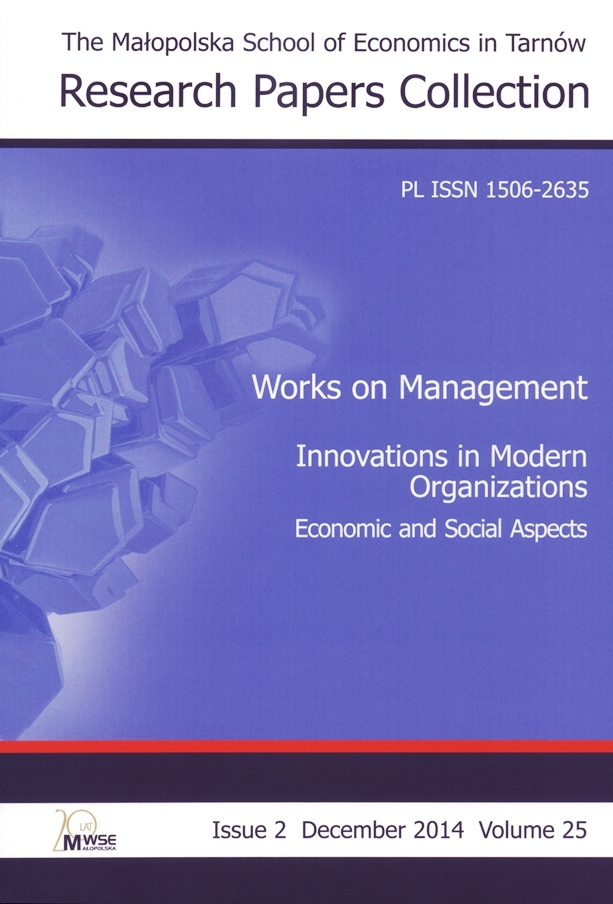Abstrakt
Promocja marek, usług oraz produktów przy użyciu form reklamy cyfrowej jest obecnie strategicznie stosowana przez organizacje, aby dotrzeć do klientów. Ten rodzaj reklamy wykorzystuje media cyfrowe do dystrybucji przekazów marketingowych i komunikacyjnych, aby promować interakcyjność i podnieść efektywność. W ten sposób celem staje się zarówno obsługiwanie, jak i angażowanie klientów. Niniejsza praca dowodzi, że media społecznościowe mogą tworzyć wirtualną społeczność, która rozpowszechnia „poczucie przynależności” do takiej społeczności wśród potencjalnych klientów, aby czuli się jej częścią, nawet jeśli nigdy się nie spotkali. Media społecznościowe mają do odegrania istotną rolę w kreowaniu doświadczenia – doświadczenia marki w internecie – oraz angażowaniu w ten proces konsumentów, umożliwiając „e-doświadczenie”i ich uczestnictwo, które może mieć pierwszorzędne znaczenie. Menadżerowie odpowiedzialni za zarządzanie mediami społecznościowymi mogą zabierać głos w dyskusjach konsumenckich w sposób zgodny z misją organizacji; tworząc blogi i sieci integrujące klientów, mogą oni wymusić tworzenie e-społeczności, które można urzeczywistnić przy użyciu określonych symboli oraz języka znanego danej grupie internetowej. Integracja mediów społecznościowych w programie marketingowym organizacji lub spółki jako narzędzia składa się z innowacyjnej procedury współtworzenia doświadczenia z konsumentem.
Bibliografia
Advertising on Facebook (2014) [online, accessed: 2014-02-23]. Retrieved from: https://www.facebook.com/help/247824495237141.
Zobacz w Google Scholar
Anderson, B. (1991). Imagined communities. London: Verso. ISBN 978-0-86091-546-1.
Zobacz w Google Scholar
Baum, N. (2011). Social networks 2.0. In: R. Burnett, M. Consalvo, Ch. Ess (eds.). The handbook of Internet studies (pp. 384–405). Malden: Wiley-Blackwell. ISBN 978-1-4051-8588-2.
Zobacz w Google Scholar
Brakus, J., Schmitt, B., Zarantonello, L. (2009). Brand Experience: What is it? How is it measured? Does it affect loyalty? Journal of Marketing, 73, 52‒68.
Zobacz w Google Scholar
Burnett, R., Consalvo, M., Ess, Ch. (eds.) (2011). The handbook of Internet studies. Malden: Wiley-Blackwell. ISBN 978-1-4051-8588-2.
Zobacz w Google Scholar
Cover Photos Carrefour Marinopoulos Super Market (2014) [online, accessed: 2014-02-25]. Retrieved from: https://www.facebook.com/photo.php?fbid=669749589714945&set=a.418676971488876.92299.416207085069198&type=1&theater.
Zobacz w Google Scholar
Cutler, K. M. (2012). Stats: Facebook made $9.51 in ad revenue per user last year in the U.S. and Canada [online, accessed: 2014-02-23]. Retrieved from: http://techcrunch.com/2012/05/03/stats-facebook-made-9-51-in-ad-revenue-per-user-last-year-in-the-u-s-and-canada/.
Zobacz w Google Scholar
Danias, K., Kavoura, A. (2013). The role of social media as a tool of a company’s innovative communication activities. The Małopolska School of Economics in Tarnów Research Papers Collection, 23 (2), 75‒83.
Zobacz w Google Scholar
Dijck, J. van (2013) ‘You have one identity’: Performing the self on Facebook and LinkedIn. Media, Culture and Society, 35, 199‒235.
Zobacz w Google Scholar
Facebook Basics (2014). Facebook for business [online, accessed 2014-06-18]. Retrieved from: https://www.facebook.com/business/overview.
Zobacz w Google Scholar
Facebook Photobucket (2010) [online, accessed 2014-06-15]. Retrieved from: http://media.photobucket.com/user/mafiashaolin/media/736444d4.png.html?filters[term]=facebook&filters[primary]=images&filters[secondary]=videos&sort=1&o=19.
Zobacz w Google Scholar
Kavoura, A., Bitsani, E. (2013). E-branding of rural tourism in Carinthia, Austria. Tourism. An International Interdisciplinary Journal, 61, 289‒312.
Zobacz w Google Scholar
Kavoura, A., Pelet, J. E., Rundle-Thiele S., Lecat, B. (2014). Experience matters: Exploring the experience behavioral loyalty relationship in wine. 2014 Global Marketing Conference at Singapore, Wine Marketing and Management Track, 15–18 July 2014.
Zobacz w Google Scholar
Kilamby, A., Laroche, M., Richard, M. O. (2013). Constitutive marketing. Towards understanding brand community formation. International Journal of Advertising, 32, 45‒64.
Zobacz w Google Scholar
Kozioł, L., Wojtowicz, A., Pyrek, R. (2013). Development οf pro-innovative culture as self-improvement οf an organization. 3rd International Conference on Quantitative and Qualitative Research on Administration Sciences, 23–24 May 2013.
Zobacz w Google Scholar
Marwick, A., Boyd, D. (2010). I tweet honestly, I tweet passionately: Twitter users, context collapse, and the imagined audience. New Media and Society, 13, 114‒133.
Zobacz w Google Scholar
Noff, A. (2011). What’s next in Social Media [online, accessed: 2014-02-22]. Retrieved from: http://thenextweb.com/socialmedia/2011/06/14/whats-next-in-social-media/.
Zobacz w Google Scholar
Papacharissi, Z. (2009). The virtual geographies of social networks: A comparative analysis of Facebook, LinkedIn and Asmall World, New Media and Society, 11, 199‒220.
Zobacz w Google Scholar
Perkel, D. (2006). Copy and paste literacy: Literacy practices in the production of a MySpace profile [online, accessed: 2014-02-22]. Retrieved from: http://people.ischool.berkeley.edu/~dperkel/media/dperkel_literacymyspace.pdf.
Zobacz w Google Scholar
Salesforce Exacttarget Marketing Cloud [online, accessed: 2014-06-18]. Retrieved from: http://www.salesforcemarketingcloud.com/.
Zobacz w Google Scholar
Salesforce.com (2013). The Facebook Ads Benchmark Report [online, accessed: 2014-02-25]. Retrieved from: http://www.salesforcemarketingcloud.com/wp-content/uploads/2013/06/The-Facebook-Ads-Benchmark-Report.pdf?b9be0c.
Zobacz w Google Scholar
Siomkos, G., Tsiamis, J. (2004). Στρατηγικό Ηλεκτρονικό Μάρκετινγκ [Strategic Electronic Marketing]. Athens: Stamouli. ISBN-13 978-960-351-523-4.
Zobacz w Google Scholar
Stavrianea, A., Kavoura, A. (2014). Communicating the sense of belonging to an ‘imagined community’ of a destination for advertising its proposed experiences and the creation of brand loyalty. Paper presented at the 2nd International Conference on Marketing and Management Issues Athens, 18–20 June, pp. 1024‒1030.
Zobacz w Google Scholar
Timeline Photos Pampers (2014) [online, accessed: 2014-02-25]. Retrieved from: https://www.facebook.com/photo.php?fbid=615978555133472&set=a.392556127475717.88410.387240021340661&type=1&theater.
Zobacz w Google Scholar
Warren, C. (2010). When are Facebook users most active? Study [online, accessed: 2014-02-23]. Retrieved from: http://mashable.com/2010/10/28/facebook-activity-study/.
Zobacz w Google Scholar
Weise, K. (2011). A lie detector test for online reviewers [online, accessed: 2014-02-23]. Bloomberg BusinessWeek, 29th September. Retrieved from: http://www.businessweek.com/magazine/a-lie-detector-test-for-online-reviewers-09292011.html.
Zobacz w Google Scholar
Zhang, J. (2010). Social media and distance education [online, accessed: 2014-02-22]. Retrieved from: http://deoracle.org/online-pedagogy/emerging-technologies/social-media-and-distance-education.html?PHPSESSID=adb9b0c9f094d0d923de6f3b3f65ef7a.
Zobacz w Google Scholar
© Copyright by Małopolska Wyższa Szkoła Ekonomiczna w Tarnowie. Artykuły są udostępniane na podstawie Creative Commons Attribution Uznanie autorstwa - Użycie niekomercyjne - Bez utworów zależnych 4.0 Licencja Międzynarodowa


